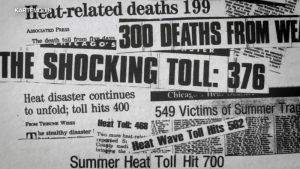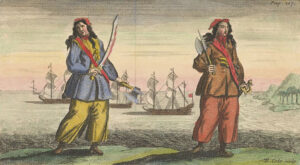As you are coming to the end of your long journey, you’re overwhelmed with the idea that you’ll be home soon, accompanied by warm, familiar faces. However, when you return home, you’re not welcomed by friends and family, but by silence and only the howl of the wind. You look around and not a single soul is in sight. Not one person in your home or in your whole village. A frightening scenario, isn’t it? This was the startling reality that John White and his fellow colonists were faced with when they returned home from their long voyage. His home was none other than the infamous Roanoke Colony.

In 1587, John White led 113 men, women, and children to Roanoke island on behalf of Queen Elizabeth I, in order to establish a New World colony, and claim riches for the queen and people of England.1 The land was somewhat familiar as it had been a previous military outpost.2 However, its first attempt at establishing a colony there had failed. John White and his men were determined not to fail their Queen on this attempt. They especially did not want to fail their investor, Sir Walter Raleigh, like others had in the past. So they went to all extents to make sure their colony’s needs were met.3 The colony seemed to settle well; however, they quickly outgrew supplies, which were essential for the long-term establishment of the colony; so now governor of Roanoke, John White, sailed back to England in order to restock. Upon his arrival in London, he was met with war with Spain and the Spanish Armada, England’s enemy at the time. Storms and many other factors made the return back to Roanoke a long one, one of years, leaving the colonists to wonder when their leader would return.4
Once John White and his men returned, Roanoke was bereft of all its colonists. They recalled that on their way to Roanoke, once already on land, they found a few footprints from Indians.5 However, they made nothing of it at the time. When they reached the village, White came across the letters “CRO” carved on a tree and the word “CROATOAN” carved on a post. Upon further inspection, it seemed that all the houses that the Roanoke Colonist were living in had been dismantled. After seeing this, White was more at ease because he believed that they had relocated to Croatoan, where the Croatoan tribe lived. This was due to the fact that White told the colonists that if they ever relocated, they were to carve the name of their new location somewhere visible. If the move or escape was out of distress, they were also to carve a Maltese cross, but none were in sight. One small thing bothered White though. He had told the colonists to hide his valuables underground, but he found that some were scattered and others were lost. In the end, for a reason unknown, White only looked for the colony one time, but didn’t find them. After this failed attempt, he made no others.6
One question still lingered in the mind of many others: what happened to the Roanoke colonists? It’s said that they were never seen again by Europeans, but there were also many speculated accounts of their whereabouts and fate. In 1608, John Smith wrote in his book that the Indians reported to him of people that looked like him. George Percy, another colonist, reported seeing a white boy with blonde hair among the Indians. Smith later sent two missions towards the south in order to find evidence of the remaining colonists, eventually learning that they were killed.7

Later, a twenty-one-quartz stone was discovered that is believed to have been a “grave marker” for the Roanoke deceased. On the smooth side of the stone was a cross and on the other were passages, speaking of deaths within the colony along with the years.8 As a last matter, in 1612, writer William Strachey reported that the Roanoke Colony did indeed live in harmony with the Chesapeake Indians for twenty-five years. Both the Indians and colonists shared knowledge and lived together until Powhatan, a leader of another Indian tribe called the Powhatan, slaughtered the colonists and the Indians sheltering them in fear that a rival to him would appear from within their tribe. A few of the colonists escaped and were later spared when they were found due to the fact that they worked well with copper, making them valuable. Still many wondered if these were facts or just stories that people wanted to hear.9 In the end, all the evidence points to the fact that the Roanoke colonists are not lost to history, but were rather killed off by brutal Indians. There is no mystery left, it’s just a matter of connecting the dots.
- The Gale Encyclopedia of the Unusual and Unexplained, 2003, s.v. “The Desertion of Roanoke,” by Brad Steiger and Sherry Hanson Steiger; Karenne Wood, “The Roanoke Colony,” South Atlantic Review 77, no. 1/2 (2012): 178-79. ↵
- Lee Miller, Roanoke Solving the Mystery of England’s Lost Colony (London: Pimlico, 2001), 7-9. ↵
- Karenne Wood, “The Roanoke Colony,” South Atlantic Review 77, no. 1/2 (2012): 178-79. ↵
- Lee Miller, Roanoke Solving the Mystery of England’s Lost Colony (London: Pimlico, 2001), 10-11. ↵
- Karen Odahl Kupperman, Roanoke The Abandoned Colony (New Jersey: Rowman & Allanheld, 1984), 133-135. ↵
- Karen Odahl Kupperman, Roanoke The Abandoned Colony (New Jersey: Rowman & Allanheld, 1984), 136-137. ↵
- Karen Odahl Kupperman, Roanoke The Abandoned Colony (New Jersey: Rowman & Allanheld, 1984), 137-139. ↵
- Haywood J. Pearce, “New Light on the Roanoke Colony: A Preliminary Examination of a Stone Found in Chowan County, North Carolina,” The Journal of Southern History 4, no. 2 (1938): 148-150. ↵
- Karen Odahl Kupperman, Roanoke The Abandoned Colony (New Jersey: Rowman & Allanheld, 1984), 139. ↵



114 comments
Victoria Cantu
Very informative article! I enjoyed reading this article from beginning to end! Based on the facts given I can see why you assume the colony was killed off by Indians. Although we may never truly never comprehend what happened to the colony, I will always consider that they either resettled or were killed. I also frankly enjoyed reading the part where the “Dare Stone” was written about. I had never once been informed by this piece of information and truly believe it makes a difference in many people’s views on what happened. I, personally, felt more confident in my opinion after learning about the stone. Overall, the story line was short but factual. It got straight to the point and made it easy to comprehend the history of how the colonization of the colony began.
Ashly Orta
Loved your introduction paragraph! It really dives into the mind of John White the day he arrived at the Roanoke Colony and finding it deserted. It is overwhelming to think that something like that happened and not have the knowledge of what happened to your family. Your article really dives into different theories and accounts of what could have happened to the Colony, but I am still amazed that White only searched once for the colony and gave up.
Madeline Bloom
This article was written very well. I never knew of the Roanoke colony and that they were slaughtered by the Indian tribe. You captured the setting very well. I thought I was really there. I wonder why he did not continue the search and why he chose to protect his belongings then his own people. He returned to nothing after he left to adventure off.
Alexandra Camarena
I personally loved this article! I have always taken interest in the disappearance of the Roanoke Colony, so to learn more about it was very fascinating. One of my favorite parts of the article was the way that the author started the article. By making the introduction a story it engages the reader to keep the article. The way the author told the story made the reader feel like they were in the story, which brings the story to life.
Emily Davey
Very interesting article, I hadn’t heard of the two carvings of the name, only of the one on the post. The rock was new too, and the fact that Smith only went searching for the colonists once. I wonder why he didn’t continue his search, and why he seemed to prioritise the safety of his valuables above the safety of all his colonists? I have heard of theories that the colonists were in part killed off by Natives, while others fled to live amongst the Croatoan Tribe, hence the tip Smith got of people who looked like him living with Natives. Fascinating mystery of that era of colonization, I hope one day we’ll know more about what happened to the people of Roanoke.
Courtney Mcclellan
The opening of this article highlights the horror that John White felt when returning to the empty colony because it causes the reader to think about their own reaction to this situation.The intricate detail of the plan for the colonists if White wasn’t able to make it back helps emphasize that they most likely did not simply disappear.The primary sources of the discoveries of the rock and the people that were seen further highlight the “disappearance” of the colonist.
Mckenzie Gritton
Ive always found Roanoke so interesting. I used to live an hour away from where the colony used to be, and every one says they joined the Native Americans. This article was really well paced and I loved the beginning. It really captures the readers attention. I don’t understand why he didn’t look more than once. If my whole village went missing id want to try to find out what happened.
Velma Castellanos
I always used to hear about the Roanoke’s in class and wondered what happened to them. There are so many unanswered questions about them. I enjoyed your article because you had an interesting theory saying they were all killed off by Indians. You explain in good detail why you came to this conclusion and makes me lean more towards the fact they were most likely killed off. Overall this is a great article that I enjoyed reading. Also great job listing your credits and images.
Seth Roen
Great article; we honestly don’t give the first English colonies enough time for as necessary they are regarding our history. Imagine returning to the home that you work hard and only return to nothing, with only a confusing message—and never knowing where your people have moved to or are still alive. To me, that would be a terrible burden on our mind of the reminder of our days.
Marycarmen Sanchez
I feel like anything I’ve read about the Colony of Roanoke has just been theories and rich with assumptions, but this article is different. This article maps out all of these ideas very well and helps me follow along with ease. I enjoy when articles give me a first-person perspective into the minds of others, and at the beginning of this one, I could really begin to resonate with the fear of John White. I liked how you talked about all aspects and theories, while also having a plausible ending to what happened to the Lost Colony of Roanoke.